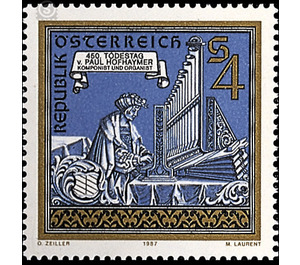450th anniversary of death - Austria / II. Republic of Austria 1987 - 4 Shilling
Theme: Art & Culture
| Country | Austria / II. Republic of Austria |
| Issue Date | 1987 |
| Face Value | 4.00 |
| Color | yellow violet |
| Printing Type | combination printing |
| Stamp Type | Commemorative |
| Item Type | Stamp |
| Chronological Issue Number | 1242 |
| Chronological Chapter | OOS-OE2 |
| SID | 875808 |
| In 60 Wishlists | |
The musician and organist Paul Hofhaymer was born on 25 January 1459 as the son of a wealthy citizen in Radstadt. In 1480 he was brought by Herzog Sigmund as organist to the court in Innsbruck, where he succeeded Niclas Krondorfer. After a short trial period, he got a job for life there. The tasks of an organist at that time were different from what one imagines today. Required were not only the game on large church organs and small positives, but also on all other then common keyboard instruments, such as clavichord or shelf. Even the play of the lute and harp was required. When Emperor Maximilian took over the government in Tyrol in 1490, he left Hofhaymer in his position. The busy travel of Maximilian also forced the great organist very often to follow his master. As a result, he was also often used for the construction of new organs, in 1491 he built, for example, the new organ in Innsbruck. The death of Maximilian in 1519 meant a profound change in Hofhaymer's life, for it endangered his previously secure existence. It is certain that he was in Salzburg from 1524 onwards. He remained there until his death in 1537. Only a fraction of his works have survived, and so the musician of his time was gradually forgotten. From his extensive liturgical organ creation only two works are handed down, a "Recordare" and a "Salve regina".


